Critically endangered species list 2024 with pictures and facts. Discover the world's most endangered species and test your knowledge with a FREE printable worksheet.
Critically Endangered Species: The World's Most Endangered Species
Critically Endangered is the conservation status given to the world's most endangered species.
Critically endangered species include orangutans, gorillas and the black rhino; reptiles such as the Hawksbill sea turtle and bog turtle; amphibians such as the axolotl and Chinese giant salamander; and insects such as the rusty patched bumblebee and golden-eyed stick insect.

The criteria by which animals are judged to be critically endangered are set by the International Union for Conservation of Nature (IUCN). (Website)
All of the animals on the list below are currently (as of Jan 2024) listed as “Endangered” by the IUCN.
A severe decline in either a species’ population size or the area in which it is found can lead to it becoming listed as Critically Endangered, which is one of three categories used by the IUCN for threatened species (the other categories are "Endangered" and "Vulnerable").
- You can see a list of currently endangered animals on this page: Endangered Animals List with Pictures & Facts
- You can see a list of animals that went extinct in 2023 on this page: Extinct Animals 2023
- Read exciting stories featuring endangered animals in our Tales From The Brink endangered animal story books
Critically Endangered Species Printable Worksheet

Test your knowledge of critically endangered species with this FREE printable question sheet. No sign-up required, just click here or on the above image to download and print.
A list of species that are critically endangered in 2024, with pictures and facts. Click on the species' names to go directly to that animal, or scroll down to browse all of the animals on the list.
Critically Endangered Species List
- American Burying Beetle
- Axolotl
- Beluga
- Black Rhino
- Bog Turtle
- California Condor
- Chinese Alligator
- Chinese Giant Salamander
- Coral Pink Sand Dunes Tiger Beetle
- Duskytail Darter
- European Eel
- European Mink
- European Sea Sturgeon
- Golden-Eyed Stick Insect
- Gorillas
- Great Hammerhead
- Hawksbill Turtle
- Hooded Vulture
- Indian Vulture
- Indri
- Lesser Antillean Iguana
- Malaysian Giant Turtle
- Mountain Chicken
- North Atlantic Right Whale
- Oceanic Whitetip Shark
- Orangutans
- Peacock Tarantula
- Philippine Eagle
- Red Wolf
- Rice's Whale
- Rusty Patched Bumble Bee
- Saola
- Sunflower Sea Star
- Vaquita
- Variable Harlequin Frog
- Western Long-Beaked Echidna
The list above contains over 30 critically endangered species, but represents only a fraction of species that are currently critically endangered. In addition to many more animals, there are also many plants, fungi and other organisms that are in this category.
A species' conservation status is liable to change as the results from new research become available. All of the animals on this page are classified "Critically Endangered" as of January 2024.
What is your favorite animal on this list? Have you got any questions on these or any other threatened animals? Let us know in the comments section at the bottom of the page.
American Burying Beetle

- Scientific name: Nicrophorus americanus
- Type of animal: Insect
- Where found: North America
The American burying beetle (also known as the giant carrion beetle) is a member of the carrion beetle family Silphidae. Beetles in this family play an important ecological role by feeding on carrion (dead animals).
The American burying beetle is a large beetle, reaching lengths of up to 1.77 in. / 45 mm. It is black, with orange spots on its wing-cases and a large orange spot behind the head.
The life cycle of the American burying beetle revolves around carrion. After locating a suitable carcass, a male will attract a mate and together they will bury the dead animal. After mating, the female lays her eggs near the carrion.
Unusually for insects, the American beetle exhibits parental care. Both parents remain with their eggs and feed their larvae from the carrion.
The American burying beetle was originally found in 35 US states and 3 Canadian provinces. Today this critically endangered species is present only in the US states of Rhode Island, Oklahoma, Arkansas, and Nebraska.
Why Are American Burying Beetles Endangered?
There is no single clear reason why the American burying beetle is endangered. Pesticide use, a change in agricultural practices resulting in fewer small animal carcasses, and habitat loss are all thought to have contributed to the beetle’s decline.
- You can find out more about beetles on this page: Beetle Facts
Axolotl

- Scientific name: Ambystoma mexicanum
- Type of animal: Amphibian
- Where found: North America
Unlike most amphibians, the axolotl doesn’t metamorphosize into an air-breathing, land-living animal; even as an adult it retains its gills and remains fully-aquatic.
The axolotl is much-studied due to its ability to re-grow its limbs and other body parts.
This critically endangered amphibian is today found in just three sites in Mexico City. Its wild population is estimated to consist of just 50 to 1,000 adult individuals. (By contrast, the human population of Mexico City, the capital city of Mexico, exceeds 9 million.)
Why Are Axolotls Endangered?
The axolotl is endangered due to habitat loss. The species was originally found in two lakes: Lake Xochimilco and Lake Chalco. Lake Chalco no longer exists, having been drained to prevent flooding. Lake Xochimilco too has been largely destroyed; remnants of the lake now form canals in Mexico City.
- You can find out more about axolotls on this page: Axolotl Facts
- You can discover more amphibians on this page: Amphibians Examples
Beluga

- Scientific name: Huso huso
- Type of animal: Fish
- Where found: Black Sea Basin, Caspian Sea Basin
The beluga is a large fish belonging to the sturgeon family, Acipenseridae. Growing to lengths of over 7m / 23 ft., it is the largest sturgeon, the world’s largest freshwater fish, and the 8th largest living fish.
Like other sturgeons, the beluga has a long body that is armored with rows of bony plates.
The beluga, like the beluga whale, gets its name from the Russian word for "white".
The beluga is found in the Black and Caspian Sea Basins, including the Danube and Volga rivers.
The species is traditionally hunted for its valuable roe, which is known as beluga caviar. Today, the beluga is threatened by overfishing, poaching, and by the building of structures such as dams on the rivers in which it is found.
- You can find out more about fish on this page: Fish – The Ultimate Guide
- Discover different types of fish on this page: Types of Fish
Black Rhino
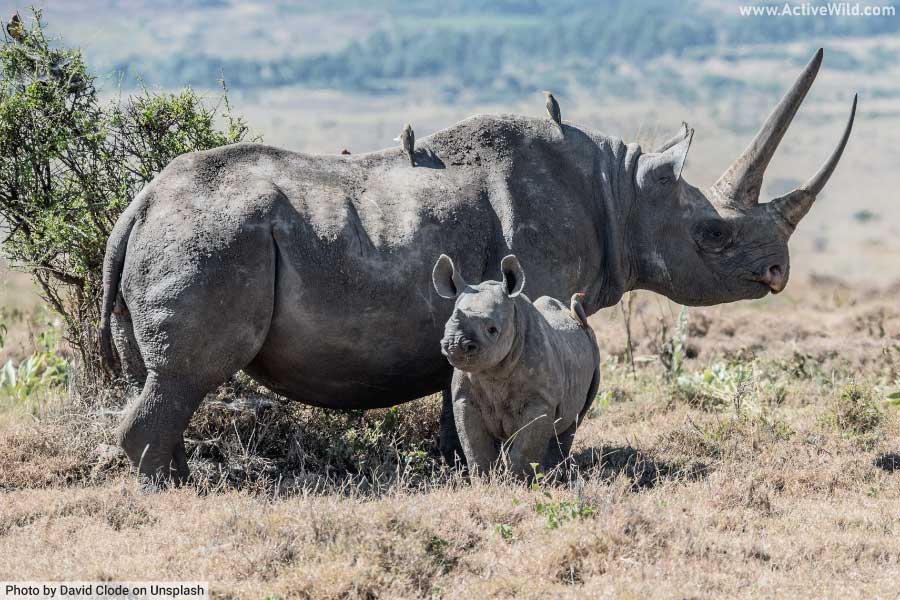
- Scientific name: Diceros bicornis
- Type of animal: Mammal
- Where found: Africa
The black rhinoceros is one of two rhino species found in Africa; the other being the much more common white rhinoceros.
Despite their names, there is little difference in the color of the two rhino species; both have gray skin. The black rhino can be identified by its pointed upper lip (the white rhino has a flat upper lip). It is also slightly smaller than the white rhino.
The black rhino is found in savanna habitats in sub-Saharan Africa. It can run at speeds of up to 34.18 mph / 55 km/h.
For much of the 20th century the black rhino had the largest population of all rhino species. Today, just over 3,000 adult individuals remain in the wild.
Why Are Black Rhinos Endangered?
The black rhino is endangered due to overhunting and habitat loss as a result of farming and human settlement. Today the species’ biggest threat is poaching; the black rhino is targeted for its horns, which are used in traditional Chinese medicine.
- You can find out more about black rhinos on this page: Black Rhino Facts
- You can see more African animals on this page: African Animals
Bog Turtle

- Scientific name: Glyptemys muhlenbergii
- Type of animal: Reptile
- Where found: North America
The bog turtle is found in bogs, waterlogged fields and wetlands in scattered populations in the northeastern and eastern United States. With an average length of 3 to 3.5 in / 7.62 to 8.89 cm, the bog turtle is the smallest turtle in North America. It can be identified by its small size and the orange spots, one on each side of the neck, behind its head.
Why Are Bog Turtles Endangered?
The bog turtle is endangered primarily due to habitat loss. It is also collected for sale to the pet trade. As its traditional habitat has undergone conversion, the species’ population has become severely fragmented.
- Discover different types of turtles on this page: Types of Turtles
California Condor

- Scientific name: Gymnogyps californianus
- Type of animal: Bird
- Where found: North America
The California condor is one of seven species in the New World vulture family, Cathartidae. It is a large, mainly black bird with a distinctive white triangle on the underside of each wing, and a bald head which is either red or orange in color.
The species has a wingspan of 9.5 ft / 2.9 m wingspan, the largest of any North American bird. (For comparison, the maximum wingspan of a bald eagle is around 7.5 ft / 2.3 m.)
The California condor is found in southwestern United States, including Arizona, Utah, and California, and in Baja California, Mexico.
The species was “brought back from extinction” with a captive breeding program. It is one of the world’s rarest birds, with a slowly growing wild population that currently consists of around 200 adult individuals.
Why Are California Condors Endangered?
The main reason that the California condor is endangered is a combination of persecution and lead poisoning (being a scavenger, the condor often eats prey that contains lead shot). DDT (a now-banned agricultural pesticide) also reduced the thickness of the species’ eggshells, resulting in fewer chicks successfully hatching.
- You can find out more about birds on this page: Birds – The Ultimate Guide
- Discover different types of birds on this page: Types of Birds
Chinese Alligator
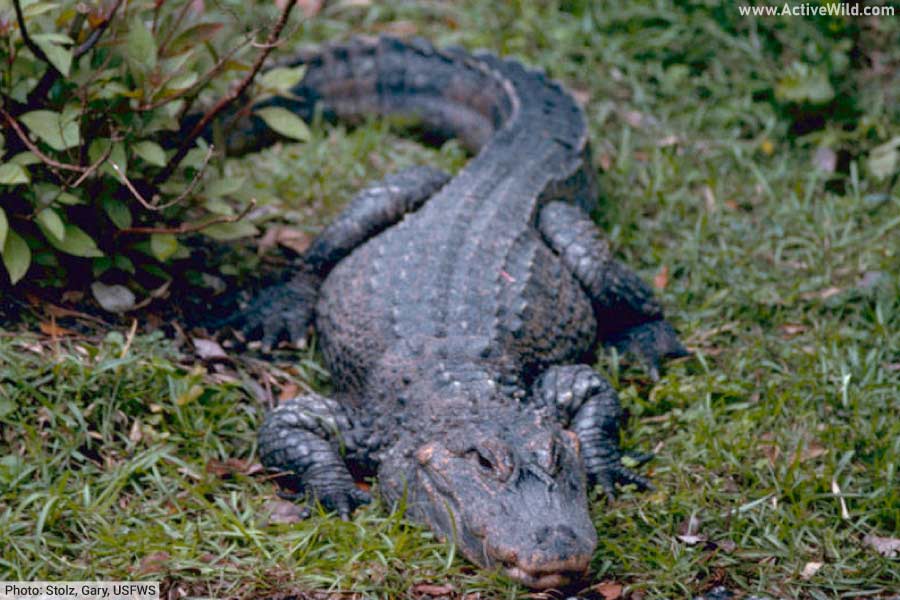
- Scientific name: Alligator sinensis
- Type of animal: Reptile
- Where found: Asia
The Chinese alligator is one of two alligator species, the other being the much larger American alligator.
The species is found in a small number of locations in Anhui Province, eastern China. Its population, which is severely fragmented, is believed to number under 100 adult individuals, making the Chinese alligator one of the world’s most endangered reptiles.
This critically endangered reptile grows to a maximum length of around 7 ft / 2.13 m; less than half the size of its American counterpart.
Why Are Chinese Alligators Endangered?
The Chinese alligator is endangered to due habitat loss and persecution. Much of the species’ habitat has been converted to rice paddies.
- Discover the difference between alligators and crocodiles on this page: Alligator vs Crocodile
- You can find out more about reptiles on this page: Reptiles – The Ultimate Guide
- Discover different types of reptiles on this page: Types of Reptiles
Chinese Giant Salamander
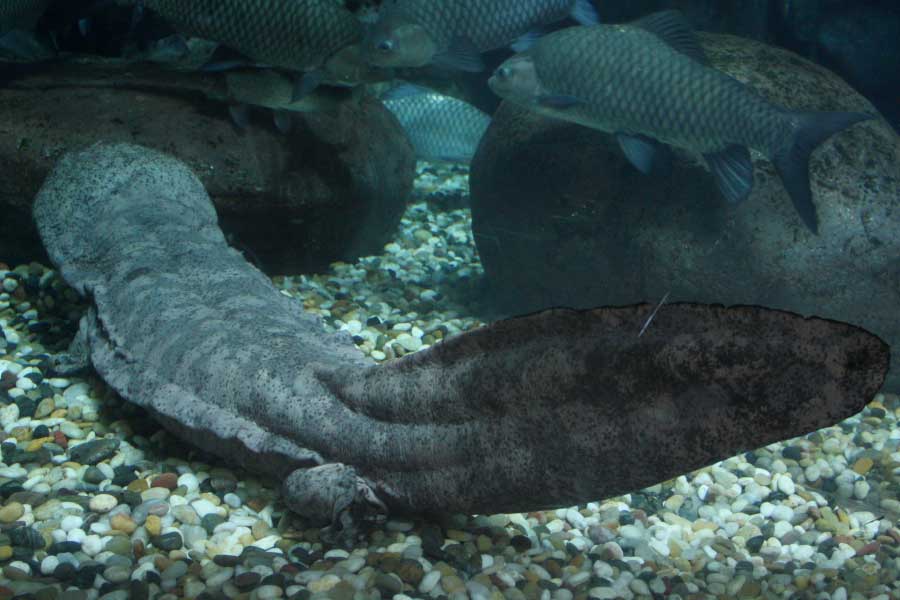
- Scientific name: Andrias davidianus
- Type of animal: Amphibian
- Where found: Asia
The Chinese giant salamander is the world’s second-largest living amphibian, reaching lengths of up to 5.9 ft / 1.8 m and weights of up to 110 lb. / 50 kg. (The largest living amphibian is the South China giant salamander, which may now be extinct in the wild.)
The Chinese giant salamander lives in quick-flowing, shallow hill streams in Central and Southern China. Even in adult form it remains fully aquatic, and is able to absorb oxygen through its skin.
Why Are Chinese Giant Salamanders Endangered?
The Chinese giant salamander is endangered due mainly to overhunting. The amphibian is considered a delicacy in China, and it is also used in traditional Chinese medicines.
Habitat loss has also led to a significant decline in the species’ population. Much of its habitat has been destroyed as a result of industrialization and the construction of dams.
- You can find out more about amphibians on this page: Amphibians - The Ultimate Guide
- You can discover more amphibians on this page: Amphibians Examples
Coral Pink Sand Dunes Tiger Beetle
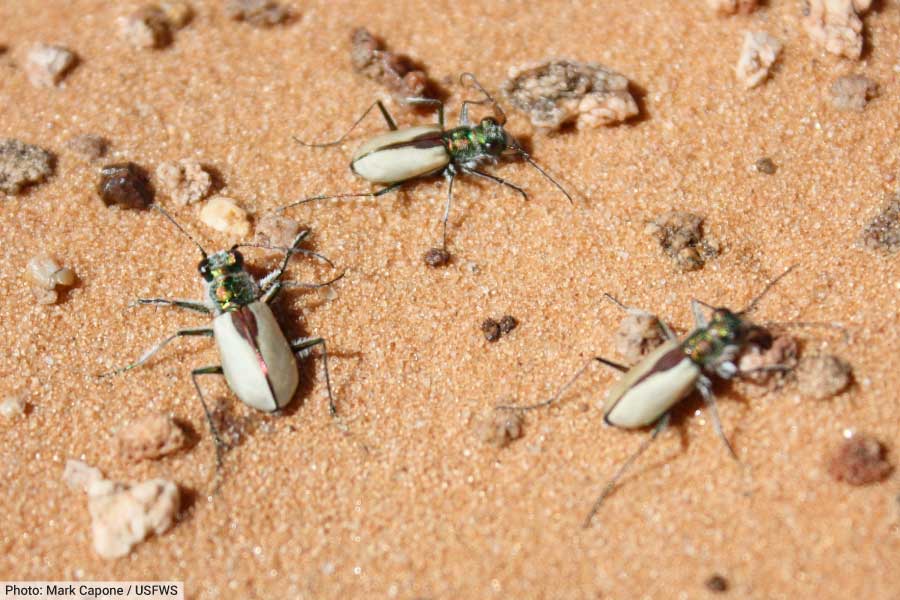
- Scientific name: Cicindela albissima
- Type of animal: Insect
- Where found: North America
The Coral Pink Sand Dunes tiger beetle is found only in the Coral Pink Sand Dunes State Park in southwestern Utah, United States. It is between 10.5 and 12 mm / 0.41 and 0.47 in. in length, and has distinctive pale elytra (wing-cases).
The beetle lives only in sand dune habitats, hunting insects such as flies and also scavenging on dead insects. It is one of around 2,600 tiger beetle species that make up the subfamily Cicindelinae, a group of beetles known for their rapid ground pursuit of prey.
Why Are Coral Pink Sand Dunes Tiger Beetles Endangered?
The use of off-road vehicles has had a negative effect on the Coral Pink Sand Dunes tiger beetle’s sand dune habitat. The species’ small population is also badly affected by drought.
- You can find out more about beetles on this page: Beetle Facts
Duskytail Darter

- Scientific name: Etheostoma percnurum
- Type of animal: Fish
- Where found: North America
The duskytail darter is a small freshwater fish found in scattered populations in the river systems of Kentucky, Tennessee, Virginia, and North Carolina.
The species is one of over 200 species in the subfamily Etheosomatidae – a group of small fishes known as “darters”.
The duskytail darter is between 2.25 and 2.5 in. / 5.72 - 6.35 cm in length, with a slender, pale brown body marked with darker bars, and two dorsal fins, the foremost of which has spines.
During the breeding season, the male develops gold-colored, fleshy caps on the spines – this is to protect the eggs that he guards after spawning them.
Why Are Duskytail Darters Endangered?
The duskytail darter is endangered due to siltation and / or pollution of its natural habitat as a result of a change in water level due to dams, weirs, etc., logging, mining and poor agricultural practices.
- You can find out more about fish on this page: Fish – The Ultimate Guide
- Discover different types of fish on this page: Types of Fish
European Eel
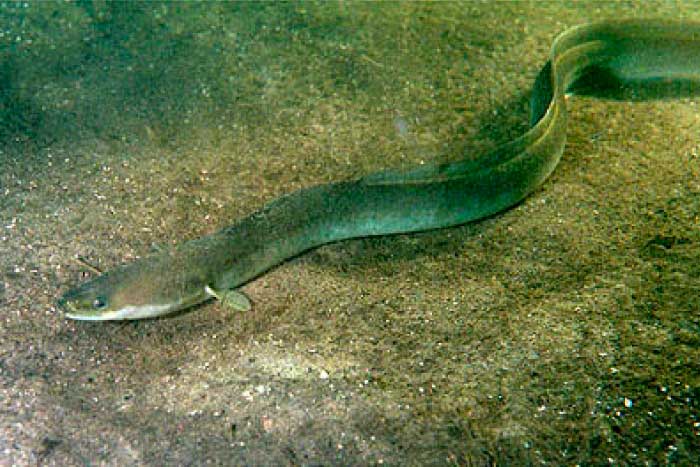
- Scientific name: Anguilla anguilla
- Type of animal: Fish
- Where found: Europe
Eels are fish in the order Anguilliformes, which contains around 800 species.
(There are also some fish known as “eels” (e.g., the electric eel) that don’t belong to this group and are therefore not “true” eels).
Eels have long, snakelike bodies, and swim by moving their whole body in waves. This means of propulsion allows an eel to swim backwards when necessary.
The European eel is typically 1.5 to 2.5 ft. / 45.72 to 76.2 cm in length. Its skin is smooth and covered in protective slime.
The European eel is migratory, making its way from its breeding grounds in the Sargasso Sea, a region of the Atlantic Ocean, to freshwater systems in Europe. After spending several years in freshwater, it returns to the Sargasso Sea to spawn.
Why Are European Eels Endangered?
The European eel is endangered due to a combination of many factors, including: overhunting, obstructions to migration, injury from hydropower turbines, habitat loss, changes to ocean currents, and disease.
- You can see more European animals on this page: European Animals
European Mink

- Scientific name: Mustela lutreola
- Type of animal: Mammal
- Where found: Europe
The European Mink is a small and elusive predatory mammal belonging to the weasel family, Mustelidae. It has a slender body and is covered in dense, dark brown fur, with a characteristic white patch on the upper lip. It is around 35-45 cm / 14 to 18 inches in length.
This semi-aquatic species inhabits riverbank environments and is adept at swimming and diving, feeding on fish, crustaceans, and small mammals.
Why Is The European Mink Endangered?
The European Mink is critically endangered due to habitat loss, pollution, and competition with the introduced American mink.
- You can see more European animals on this page: European Animals
European Sea Sturgeon
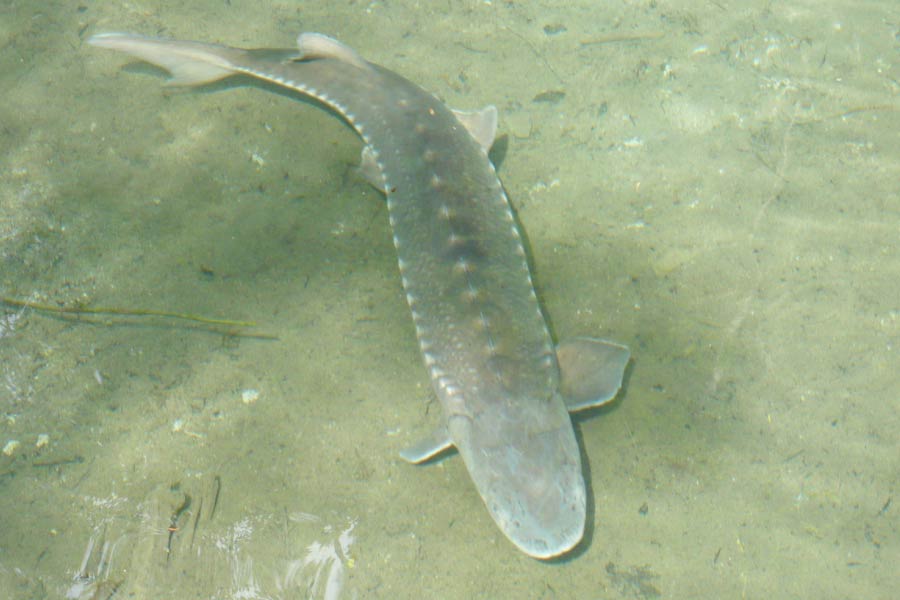
- Scientific name: Acipenser sturio
- Type of animal: Fish
- Where found: Europe
Also known as the Atlantic sturgeon, the European sea sturgeon is one of 27 species in the sturgeon family Acipenseridae. Once found in coastal waters around most of Europe, the species is now found only in France’s Garonne River.
The species, which can reach lengths of up to 11.48 ft / 3.5 m, spends most of its life at sea, before migrating into freshwater river systems to spawn. (A species that migrates from the ocean to freshwater is said to be “anadromous”.)
Why Are European Sea Sturgeons Endangered?
The European sea sturgeon was formerly used in the production of caviar and is endangered due to over-fishing. The remaining population is threatened by bycatch (accidental capture when other species are being targeted), obstacles such as dams, and river pollution.
- You can see more European animals on this page: European Animals
Golden-Eyed Stick Insect

- Scientific name: Peruphasma schultei
- Type of animal: Insect
- Where found: South America
The distinctively-colored golden-eyed stick insect is also known as the black beauty stick insect. Despite being a popular pet, the species is critically endangered in the wild. It is found only in a very small (under 5 hectares) area in the mountainous Cordillera del Cóndor region of Peru.
The golden-eyed stick insect is around 2.17 in / 5.5 cm in length, and has small, vestigial wings that are bright red in color. It is unable to fly. If threatened, it can spray its aggressor with an irritating defensive liquid.
Why Are Golden-Eyed Stick Insects Endangered?
The golden-eyed stick insect is endangered due to deforestation; much of its traditional forest habitat has been converted to plantations and fields for cattle. In addition, being flightless, the species is unable to escape from fires started by agricultural workers.
- You can find out more about insects on this page: Insects – The Ultimate Guide
Gorillas
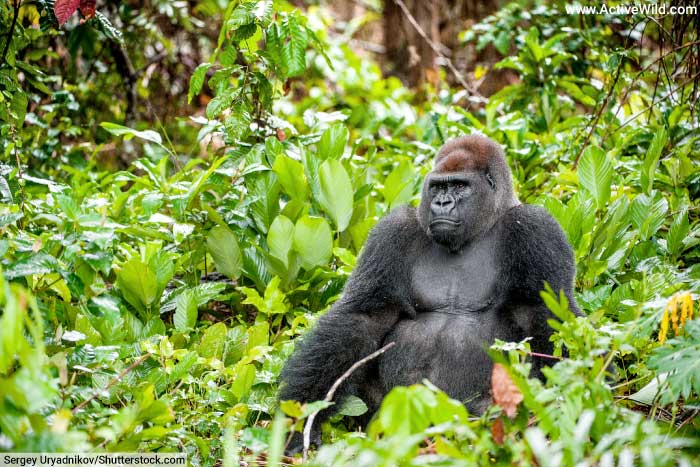
- Scientific name: Genus: Gorilla
- Type of animal: Mammal
- Where found: Africa
There are two gorilla species: the western gorilla (Gorilla gorilla) and the eastern gorilla (Gorilla beringei). Both are critically endangered.
Gorillas are the largest primates. They belong to the family Hominidae, to which humans, chimpanzees, bonobos and orangutans also belong. Members of this family are known as “great apes”.
Gorillas are herbivorous, forest-dwelling animals that live in small groups consisting of several females and their young, and a dominant adult male known as a “silverback”.
The western gorilla is slightly smaller, and usually a lighter color, than the eastern gorilla. The western gorilla has two subspecies: the western lowland gorilla and the Cross River gorilla. The eastern gorilla also has two subspecies: the eastern lowland gorilla and the mountain gorilla.
Why Are Gorillas Endangered?
Gorillas are endangered due to deforestation, hunting and disease. Deforestation is caused by logging or the conversion of forests into agricultural land (in particular oil palm plantations).
Despite gorillas being legally protected, they are still targeted for bushmeat by local hunters. Being so closely-related to humans, gorillas are susceptible to many of the same diseases, in particular Ebola virus.
You can find out more about gorillas on these pages:
Great Hammerhead
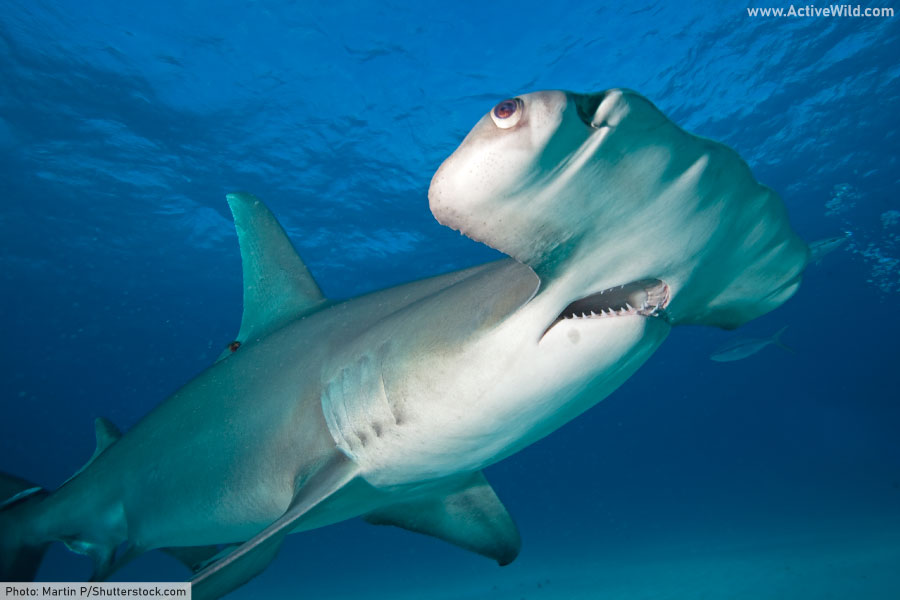
- Scientific name: Sphyrna mokarran
- Type of animal: Fish
- Where found: Tropical and warm oceans worldwide
The great hammerhead is the largest of the hammerhead sharks, a group of sharks named after the hammer-like shape of their widened heads. It can reach a maximum length of around 15 ft. / 4.57 m.
The shape of a hammerhead shark’s head is thought to have evolved to improve the animal’s sensory capabilities. The shark’s eyes are positioned on each side of the “hammer”, allowing the shark to see everything above and below it, and also improving binocular vision (the ability to gauge distances).
Sharks have electroreceptors with which they can sense electrical fields produced by the movements of other animals. A hammerhead shark’s electroreceptors are spaced along its hammer head, improving the animal’s electroreceptive ability.
The great hammerhead’s diet consists of many other types of fish (including other sharks, such as the grey reef shark). Stingrays are a favorite meal for the great hammerhead. It can detect stingrays even when they are buried in sand by using its electroreceptors.
Why Are Great Hammerheads Endangered?
The great hammerhead shark is endangered due to overfishing. In many parts of the world the species is targeted for its fins, which are used in shark fin soup. In other regions, it is caught as bycatch; even if subsequently released, the shark usually dies.
- You can find out more about the great hammerhead on this page: Great Hammerhead Shark Facts
- Find out more about sharks on this page: Shark Facts
- Discover different types of sharks on this page: Types of Sharks
Hawksbill Turtle

- Scientific name: Eretmochelys imbricata
- Type of animal: Reptile
- Where found: Tropical and subtropical oceans worldwide
The hawksbill sea turtle is one of seven species of sea turtle, and one of six in the family Cheloniidae. It can be differentiated from other sea turtles by its sharp, hooked beak (the hawklike appearance of the beak gives the turtle its name) and by the saw-like, serrated edge of the back of its shell.
There are hawksbill populations in both the Atlantic and Pacific Oceans. The species is migratory, travelling between its feeding grounds and its coastal breeding grounds. Females crawl onto land to lay their eggs on the beach. Male turtles, after hatching and entering the ocean, never again return to land.
Why Are Hawksbill Turtles Endangered?
Hawksbill turtles are endangered due to overhunting for their shells, which are used to make the decorative material tortoiseshell. The species is also hunted for its meat. In addition, many of the hawksbill turtle’s traditional nesting sites have been lost as a result of human development in coastal locations.
- You can find out more about the hawksbill sea turtle on this page: Hawksbill Sea Turtle
- You can find out more about sea turtles on this page: Sea Turtle Facts
Hooded Vulture
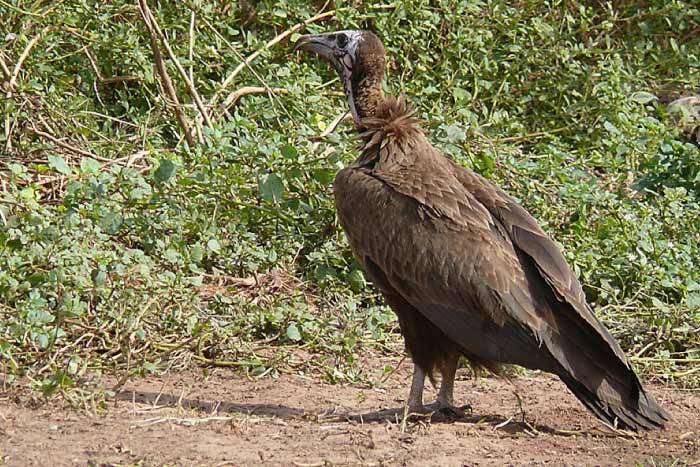
- Scientific name: Necrosyrtes monachus
- Type of animal: Bird
- Where found: Africa
The hooded vulture is an Old World vulture found in sub-Saharan Africa. (Old World vultures are only distantly related to the New World vultures, despite their physical and behavioral similarities.)
Relatively small in size for a vulture, the hooded vulture is named for the “hood” of feathers at the back of its head.
Despite being found across a wide area of sub-Saharan Africa, the hooded vulture population has declined sharply in recent years and the species has been rated as being critically endangered since 2015.
Threats to the species include poisoning, and hunting for traditional medicine and bushmeat.
- You can find out more about birds on this page: Birds – The Ultimate Guide
- Discover different types of birds on this page: Types of Birds
Indian Vulture

- Scientific name: Gyps indicus
- Type of animal: Bird
- Where found: Asia
The Indian vulture is a vulture found in India, Pakistan, Nepal and Afghanistan. It is a mid-sized species with a maximum wingspan of 7.8 ft / 2.38 m. It belongs to a group of birds within the family Accipitridae known as Old World vultures.
Despite physical and behavioral resemblances, Old World vultures are not closely related to the New World Vultures. The similarities are due to convergent evolution, a process in which unrelated species evolve similar characteristics due to a shared lifestyle or habitat.
The Indian vulture is found in urban areas including cities, as well as in shrublands, grasslands and forests. As a scavenger of carrion, it plays a vital role in the ecosystem.
Why Are Indian Vultures Endangered?
The Indian vulture is endangered due to the widespread use of the drug diclofenac, which is poisonous to the vulture, on livestock. The vulture dies after eating the carrion of animals treated with this drug.
- You can find out more about birds on this page: Birds – The Ultimate Guide
- Discover different types of birds on this page: Types of Birds
Indri
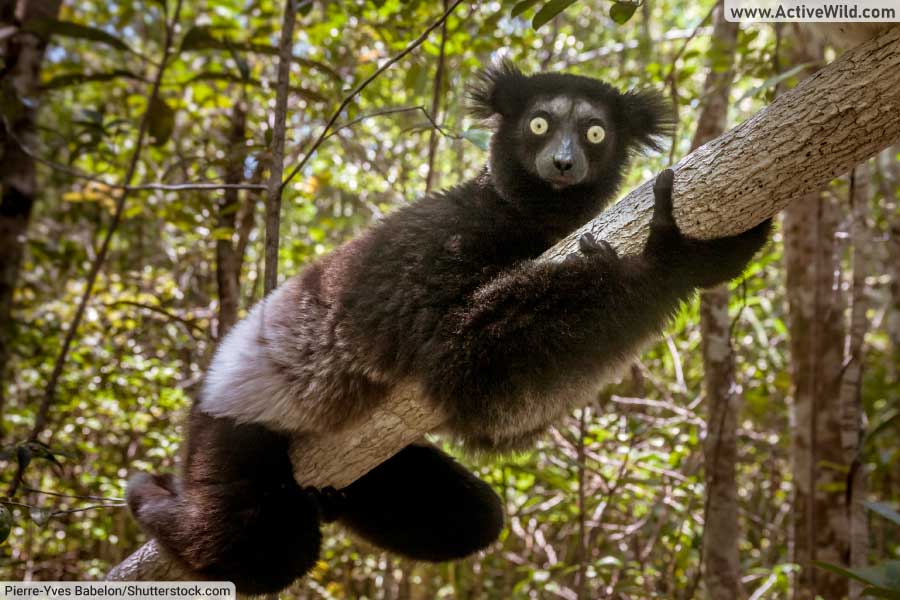
- Scientific name: Indri indri
- Type of animal: Mammal
- Where found: Madagascar
The Indri, the largest of all lemurs, is native to Madagascar. The species is notable for its black and white fur and virtually tailless body, a unique feature among lemurs.
This critically endangered primate has a body length of about 60-90 cm / 24 to 35 inches. It is known for its distinctively loud, haunting call, which resonates through the rainforests it inhabits.
The indri is herbivorous and lives in small family groups. It is arboreal and spends most of its life in the trees.
Why Is The Indri Endangered?
The indri is critically endangered due primarily to habitat destruction and hunting by local people.
- You can see more rainforest animals on this page: Rainforest Animals List with Pictures & Facts
Lesser Antillean Iguana

- Scientific name: Iguana delicatissima
- Type of animal: Reptile
- Where found: Caribbean
The Lesser Antillean iguana is a lizard found on the Lesser Antilles island group in the Caribbean. It belongs to the same genus, Iguana, as the much more common (and unthreatened) green iguana, which is found on the South American mainland and north as far as Mexico.
The Lesser Antillean iguana can be differentiated from its mainland cousin by its lack of a “subtympanic shield” – the large scale on the face of the green iguana.
The Lesser Antillean iguana lives in a variety of habitats, including forests, shrublands and rainforests. It is herbivorous, eating a variety of plant materials.
Why Are Lesser Antillean Iguanas Endangered?
The Lesser Antillean iguana is endangered due to the introduction of the green iguana to the islands on which it is found. The green iguana outbreeds and eventually displaces the Lesser Antillean iguana. Hybridization between the two species also threatens the Lesser Antillean Iguana.
- You can find out more about reptiles on this page: Reptiles – The Ultimate Guide
- Discover different types of reptiles on this page: Types of Reptiles
Malaysian Giant Turtle
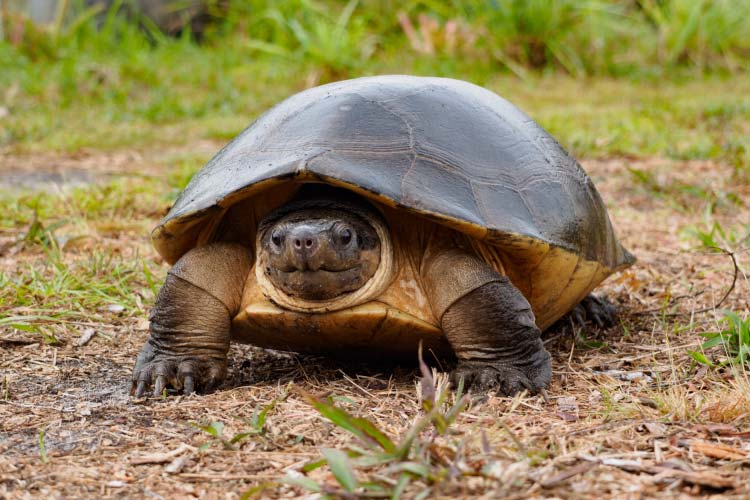
- Scientific name: Orlitia borneensis
- Type of animal: Reptile
- Where found: Asia
The Malaysian giant turtle is a large freshwater turtle found in Malaysia and on the islands of Sumatra and Borneo in Southeast Asia. It reaches 31.5 in / 80 cm in length and up to 110 lb. / 50 kg in weight.
The species inhabits swamps, lakes and rivers, and is piscivorous (fish-eating).
Why Are Malaysian Giant Turtles Endangered?
The Malaysian giant turtle is endangered due to overhunting. The species is captured and sold in local food markets. The species’ survival is also threatened by the conversion of its natural habitat into oil palm plantations.
- Discover different types of turtles on this page: Types of Turtles
Mountain Chicken

- Scientific name: Leptodactylus fallax
- Type of animal: Amphibian
- Where found: Caribbean
The mountain chicken, or giant ditch frog, is a critically endangered frog found on the islands of Dominica and Montserrat in the Caribbean. Reaching up to 2.2 lb. / 1 kg in weight, and 8.67 in / 22 cm in body length, it is one of the world’s largest frog species.
The mountain chicken is a nocturnal ambush hunter, sitting in wait for prey to come within reach before pouncing. Its diet consists of almost any animal it can fit in its mouth. This includes insects, arachnids (including tarantulas), snakes, and even bats.
Why Are Mountain Chickens Endangered?
The mountain chicken has been badly affected by the fungal disease chytridiomycosis, which has caused a global fall in amphibian populations. The species has also suffered from overhunting; the frog was historically hunted for its meat.
- You can find out more about amphibians on this page: Amphibians - The Ultimate Guide
- You can discover more amphibians on this page: Amphibians Examples
North Atlantic Right Whale

- Scientific name: Eubalaena glacialis
- Type of animal: Mammal
- Where found: North America
The North Atlantic right whale is one of 16 currently recognized baleen whales, and one of three right whales.
Baleen whales are aquatic mammals that feed by filtering small organisms from the water using comb-like structures in their mouths called baleen plates. The North Atlantic right whale’s diet consists mainly of small crustaceans such as krill.
Most North Atlantic right whales migrate from their summer feeding grounds in the Labrador Sea (an area of the North Atlantic between Canada and Greenland) and their overwintering grounds off the coasts of Georgia and Florida.
Why Are North Atlantic Right Whales Endangered?
The North Atlantic right whale is endangered due to overhunting from the 16th century to the early 20th century. The species was targeted for its oil and meat. Right whales were so-called because they were slow-moving, high in blubber, and remained floating even after having been killed, thereby making the whaler’s job easier; they were the “right” species to target.
Although the whales are no longer hunted, their main threats today come from human activity: many whales drown after become entangled in fishing nets, and ship strikes can kill or seriously injure whales swimming near the surface.
- You can see pictures and facts on EVERY species of whale on this page: Types of Whales
Oceanic Whitetip Shark

- Scientific name: Carcharhinus longimanus
- Type of animal: Fish
- Where found: Warm and temperate waters worldwide
As its name suggests, the oceanic whitetip shark is found in the open ocean, rather than in shallow coastal waters. It is a medium-sized requiem shark, rarely exceeding lengths of 3 m / 9.8 ft. Its fins have distinctive white tips.
The oceanic whitetip shark is both targeted and caught as bycatch by fishermen targeting other species. The species’ fins are a principal ingredient in shark fin soup, a delicacy in several Asian countries.
- Find out more about sharks on this page: Shark Facts
- Discover different types of sharks on this page: Types of Sharks
Orangutans

- Scientific name: Genus: Pongo
- Type of animal: Mammal
- Where found: Asia
There are three species of orangutan: Sumatran, Bornean and Tapanuli; all are critically endangered and have decreasing populations. The Sumatran orangutan (Pongo abelii) and Tapanuli orangutan (Pongo tapanuliensis) live in separate regions of the Indonesian island of Sumatra. The Bornean orangutan (Pongo pygmaeus) is found on Borneo.
Orangutans are members of the great ape family Hominidae along with gorillas, chimps, bonobos and humans. They share around 97% of their DNA with humans. Orangutans are the most arboreal (tree-dwelling) of the great apes. They are mainly fructivorous (fruit-eating), but supplement their diet with leaves, honey, insects and small vertebrates.
These distinctive red-haired primates have long arms and flexible shoulder and hip joints for climbing and moving through the trees. Orangutans can grip with both their hands and their feet.
Why Are Orangutans Endangered?
Orangutans are endangered due to deforestation; much of their natural habitat has been destroyed to make way for oil palm plantations, and logging too has also caused the destruction of huge swathes of forest. Orangutans are also hunted for bushmeat and their infants sold to the pet trade.
You can find out more about orangutans on the following pages:
Peacock Tarantula
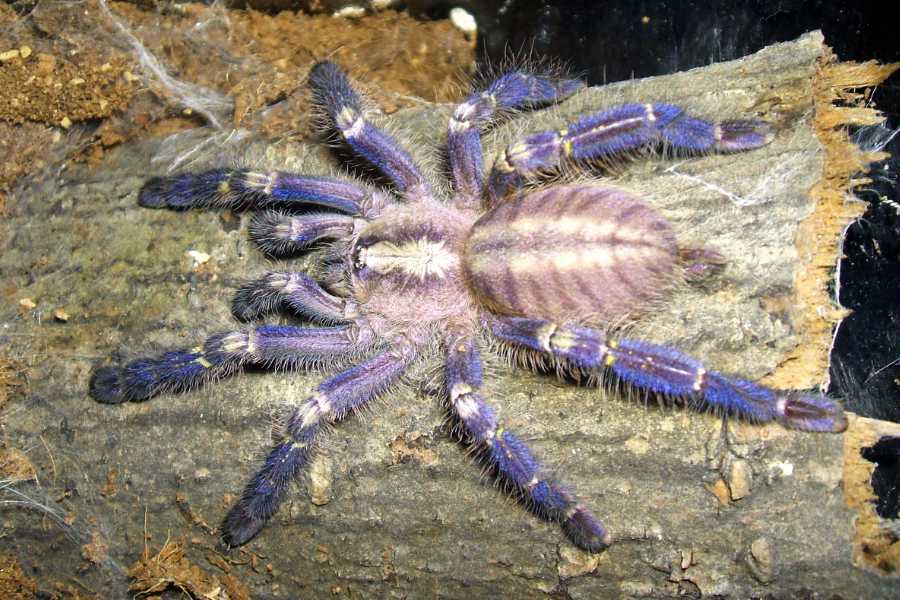
- Scientific name: Poecilotheria metallica
- Type of animal: Arachnid
- Where found: Asia (India)
The Peacock Tarantula is a visually striking spider known for its vibrant coloration. Native to a tiny patch of forest in southern India, it has a brilliant metallic blue body with a mix of greenish hues, making it a favorite among arachnid enthusiasts.
The species, relatively small for a tarantula, has a leg span of about 15 cm / 6 inches. It's known for its arboreal lifestyle, preferring to dwell in trees.
The Peacock Tarantula is a solitary and nocturnal creature, feeding primarily on insects.
Why Is The Peacock Tarantula Endangered?
Due to its specific habitat requirements and growing popularity in the pet trade, it faces threats from habitat destruction and overcollection.
- Discover different types of spiders on this page: Types Of Spiders
Philippine Eagle
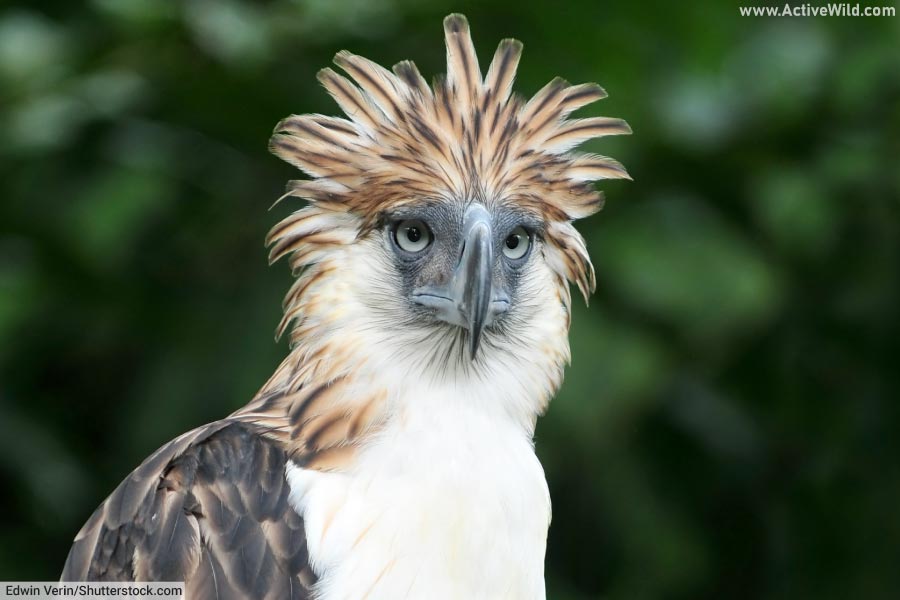
- Scientific name: Pithecophaga jefferyi
- Type of animal: Bird
- Where found: Asia
The Philippine eagle is the world’s largest eagle by wingspan and body length, and the third-largest by weight; only Steller’s sea eagle and the harpy eagle are heavier. The wingspan of the Philippine eagle can reach 7.22 ft / 2.2 m.
This critically-endangered species is endemic to (only found in) forests in the Philippines.
This critically-endangered species’ diet consists of monkeys, Philippine flying lemurs, fruit bats, snakes, monitor lizards and a variety of other mid-sized vertebrates.
Due to its diet, the species is also known as the “monkey-eating eagle”.
Why Are Philippine Eagles Endangered?
Deforestation due to logging is the main reason the Philippine eagle is critically endangered. Deliberate hunting for food, and accidental capture in traps meant for other animals have also contributed to the species’ decline.
- You can find out more about the Philippine eagle on this page: Philippine Eagle Facts
- You can find out more about birds on this page: Birds – The Ultimate Guide
- Discover different types of birds on this page: Types of Birds
Red Wolf
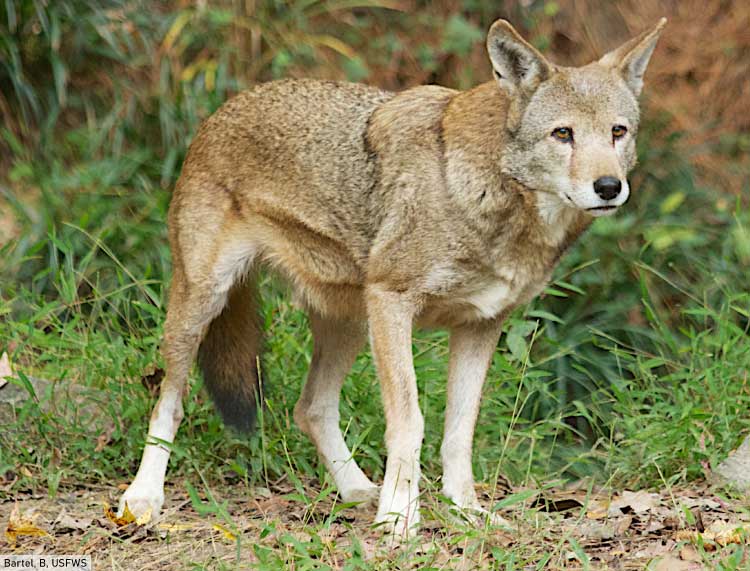
- Scientific name: Canis rufus
- Type of animal: Mammal
- Where found: North America
The red wolf is a member of the dog family Canidae that was once found across the southeastern United States. The species is now found mainly in northeastern North Carolina, after having been reintroduced to the area in a conservation project. Only 20-30 adult red wolves are thought to survive in the wild.
The red wolf resembles a cross between a wolf and a coyote, and there is disagreement over whether the red wolf is a wolf-coyote hybrid, a wolf subspecies or a separate species in its own right.
Why Are Red Wolves Endangered?
The red wolf is endangered due to habitat loss and hybridization with coyotes. Shooting and poisoning of reintroduced wolves has also occurred.
- You can find out more about the red wolf on this page: Red Wolf Facts
- You can see EVERY species of dog on this page: Wild Dog Species List with Pictures and Facts
Rice's Whale
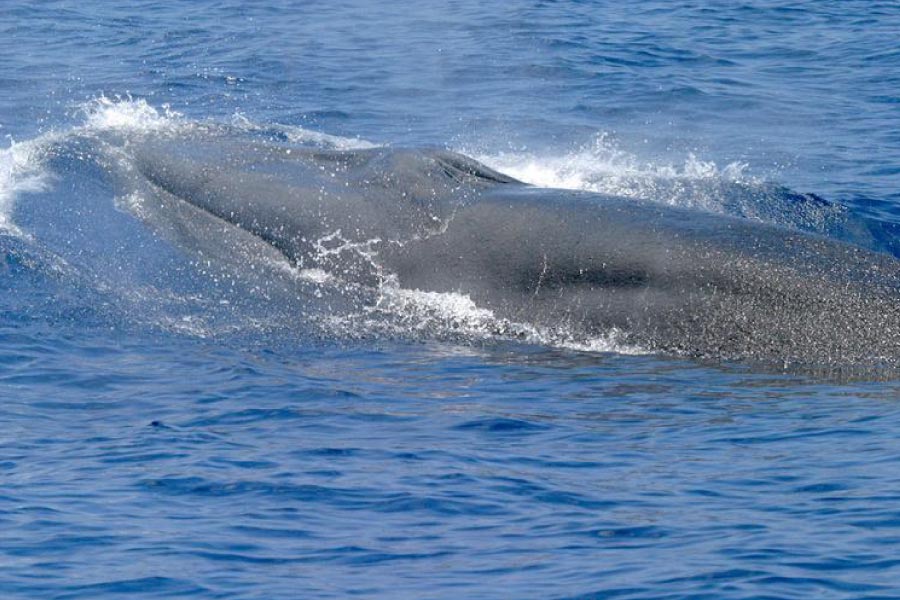
- Scientific name: Balaenoptera ricei
- Type of animal: Mammal
- Where found: Gulf of Mexico
Found only in the Gulf of Mexico, Rice’s whale is a medium-sized whale that reaches lengths of up to 12.65 meters / 41.5 ft. It is physically very similar to the closely-related Bryde’s whale, but was found to be a separate species in 2021.
One of the world’s most endangered whales, Rice’s whale was adversely affected by the Deepwater Horizon oil spill, and is threatened by entanglement in fishing gear and ship strikes.
Only an estimated 26 Rice’s adult whales are thought to remain.
- You can find out more about Rice's whale on this page: Rice's Whale
- You can see pictures and facts on EVERY species of whale on this page: Types of Whales
Rusty Patched Bumble Bee
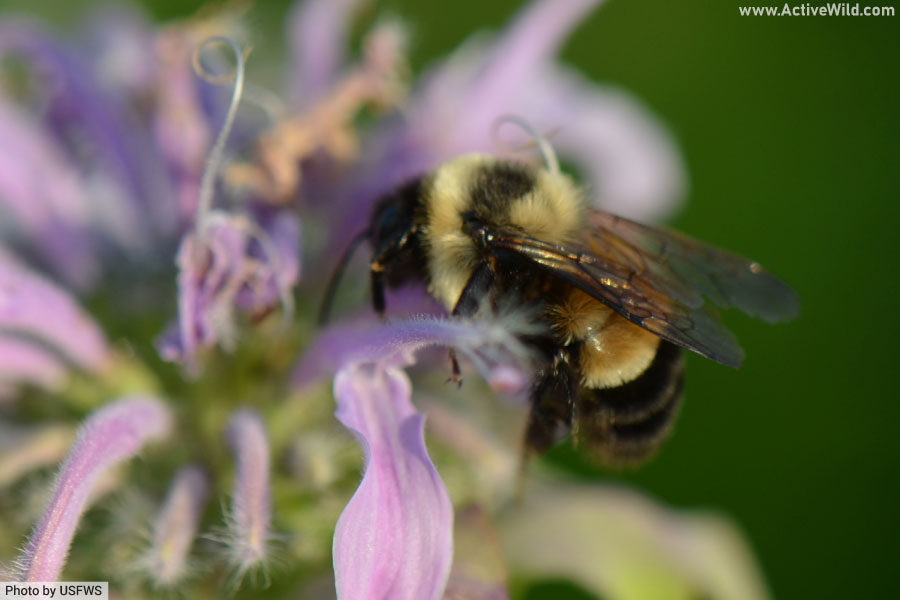
- Scientific name: Bombus affinis
- Type of animal: Insect
- Where found: North America
The rusty-patched bumble bee is a critically endangered insect found in the eastern United States and southeastern Canada.
A relatively large bumblebee, the rusty-patched bumblebee worker’s body hair is yellow with a black strip on the thorax and black at the tip of the abdomen. Amongst the yellow hair of the abdomen is a distinctive rusty-orange patch.
The rusty patched bumble bee is a colonial insect that lives in underground nests. The bee was a common sight in northeastern USA and southeastern Canada as recently as 30 years ago. Today, it is rarely seen.
The species is the first bumblebee to be listed as Endangered under the USA’s Endangered Species Act.
Why Are Rusty Patched Bumble Bees Endangered?
The rusty-patched bumblebee is endangered due to the transfer of the unicellular parasite Nosema bombi from commercial bees to wild bee species. Habitat loss caused by modern agricultural methods and pesticide use are also thought to have caused a decline in the insect’s population.
- You can find out more about the rusty-patched bumblebee on this page: Rusty-Patched Bumblebee Facts
- You can find out more about insects on this page: Insects – The Ultimate Guide
Saola

- Scientific name: Pseudoryx nghetinhensis
- Type of animal: Mammal
- Where found: Asia
The saola is a critically endangered member of the family Bovidae, which contains animals such as cattle, bison, buffalo and antelopes. The species is found in the Annamite range of mountains in Vietnam and Laos.
The saola was only discovered in 1992, after remains were found in Vũ Quang Nature Reserve. It is an extremely shy animal that is rarely seen.
Why Are Saolas Endangered?
The saola is endangered due to overhunting, both for bushmeat and for use in traditional Asian medicine.
Discover different types of mammals on this page: Types of Mammals
Sunflower Sea Star
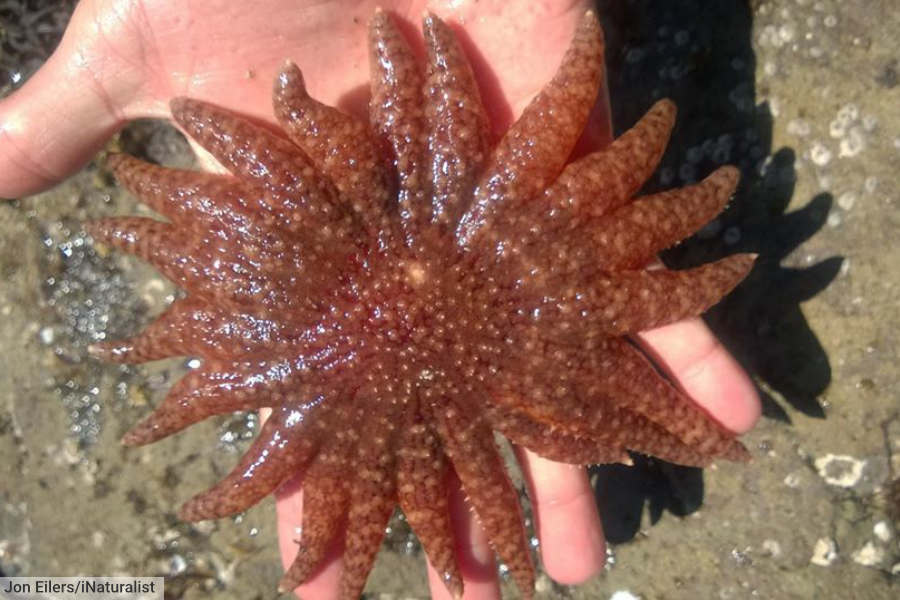
- Scientific name: Pycnopodia helianthoides
- Type of animal: Echinoderm
- Where found: northeastern Pacific Ocean
The sunflower sea star (also known as the sunflower starfish) is the world's second-largest sea star / starfish, with an arm span of up to 1 m (3.3 ft). This large marine invertebrate has up to 24 arms, and is usually orange-red in color.
Fast moving for a sea star, the sunflower sea star can reach speeds of up to 1 m per minute / 3.3 ft per minute. It preys mainly on sea urchins, but will also eat a variety of other marine invertebrate animals, including mollusks and other echinoderms.
Why is the sunflower sea star endangered?
The sunflower sea star is critically endangered due to a combination of factors, including sea star wasting syndrome—a devastating disease that causes mass die-offs—alongside the impacts of climate change, such as ocean acidification and warming waters.
You can see more echinoderms on this page: Echinoderms Examples
Vaquita

- Scientific name: Phocoena sinus
- Type of animal: Mammal
- Where found: North America
The vaquita is a porpoise found in the Gulf Of California, in Baja Mexico. This marine mammal inhabits shallow, murky waters, where it hunts fish, squid and crustaceans.
With an average length of around 4.76 ft / 1.45 m, the vaquita is the world’s smallest cetacean.
It is estimated that there are fewer than 50 vaquitas left, putting the species on the verge of extinction.
Why Are Vaquitas Endangered?
The vaquita is endangered due to gillnetting for other species. Although gillnetting in the area is now fully or partially banned in areas in which the vaquita is present, illegal fishing continues.
Discover different types of mammals on this page: Types of Mammals
Variable Harlequin Frog

- Scientific name: Atelopus varius
- Type of animal: Amphibian
- Where found: Central America
Also known as the Costa Rican variable harlequin toad and the clown frog, the variable harlequin frog is a critically endangered amphibian found in tropical and subtropical forests in Costa Rica and Panama. It belongs to the family Bufonidae, whose members are known as “true toads”.
The bright coloration of the variable harlequin frog’s skin warns potential predators that the frog is poisonous. Its skin contains a powerful neurotoxin. As a result, the amphibian has few natural predators.
Why Are Variable Harlequin Frogs Endangered?
Chytridiomycosis, a disease caused by the fungus Batrachochytrium dendrobatidis, is thought to have caused a rapid decline in the variable harlequin frog population. This disease has devastated amphibian populations in many parts of the world.
- You can find out more about amphibians on this page: Amphibians - The Ultimate Guide
- You can discover more amphibians on this page: Amphibians Examples
Western Long-Beaked Echidna

- Scientific name: Zaglossus bruijnii
- Type of animal: Mammal
- Where found: New Guinea
The western long-beaked echidna, together with three other echidna species and the platypus, are the world’s only egg-laying mammals. These five species are known as monotremes. Although monotremes lay eggs, they still feed their young with milk, which is a characteristic of all mammals.
The western long-beaked echidna is found in the Indonesian part of the island of New Guinea. The species may have been present in Australia until the beginning of the twentieth century, but is now extinct in the country.
Reaching weights of up to 36.38 lb. / 16.5 kg, the western long-beaked echidna is the largest of the four echidnas. It lives in the leaf litter of tropical forests and feeds mainly on earthworms.
Why Are Western Long-Beaked Echidnas Endangered?
The long-beaked echidna is hunted for its meat. Although commercial hunting of the species is banned, small-scale hunting, often with dogs trained for the purpose, continues.
- You can find out more about echidnas on this page: Echidna Facts
Critically Endangered Species 2024 List: Conclusion
Sources of information for this page include the International Union for Conservation of Nature (website) and the IUCN RedList.
You can find out more about endangered species on the following pages:
- Discover more endangered species on this page: Endangered Animals List with Pictures & Facts
- You can find out more about endangered animals on this page: Endangered Animals Facts
- Find out more about the animal kingdom here: Animals: The Ultimate Guide
- Discover amazing animals from all around the world: A to Z Animals List
- Read exciting stories featuring endangered animals in our Tales From The Brink endangered animal story books


